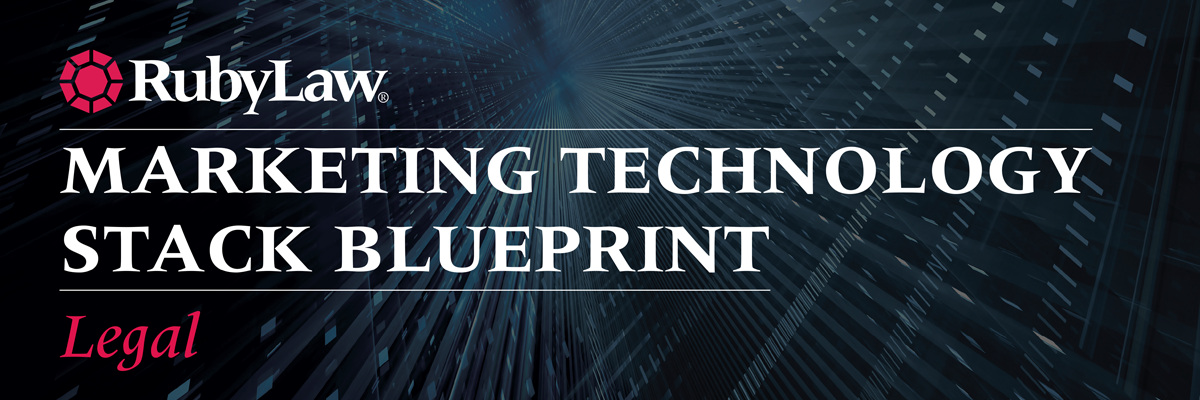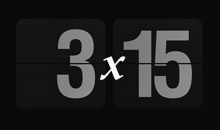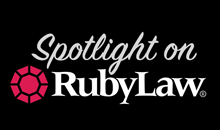Launching the 2020 Legal Marketing Technology Stack
Legal marketers and business developers are becoming increasingly reliant on technology. Yet, the time required to become educated, to make strategic decisions about particular systems, to successfully roll-out and adopt software, and to leverage it to gain a competitive advantage is as considerable as the amount required to perform general marketing and business development activities. This poses a unique dilemma: when and how can legal marketers keep on the cutting edge of marketing technology?
Enter the 2020 Legal Marketing Technology Stack, presented by RubyLaw.
Having recognized this challenge in late 2018, we focused our efforts on creating a blueprint to help law firms of all sizes think strategically about how to organize and deploy marketing technology. In early 2019, we released the first version: a visualization of the legal marketing technology ecosystem.
We adopted the categories popularized by Scott Brinker, including: Advertising & Promotion, Content & Experience, Social & Relationships, Sales, Data, and Management, and we applied them to legal. We examined technology systems used by firms of all sizes, and published the blueprint with the idea being that firms could document the current state of their technology and then be aspirational about the future, adopting new systems to accomplish new objectives, meet certain needs, and fill gaping holes.
Next, we articulated our point of view: that it’s critical to select systems of appropriate size and power while avoiding misfits. Just as no one wants to wear a pair of shoes two sizes too big, choosing powerful, “best-in-class” systems that your firm can’t use optimally (or—the opposite—trying to squeeze into a too basic of a solution when you’re a global enterprise) is wasteful. Instead, we suggested focusing on making smart, efficient decisions that align with firm culture, team capabilities, budget, and relative complexity. We believe these ideas still hold although, tech stacks are not meant to be fixed in time. Rather, they must evolve to continue supporting the ever-changing nature of business and life itself.
Finally, to validate our hypotheses, we connected with experts across legal marketing, including Patty Azimi, Mobina Panicker, Jason Kennedy, Deborah Farone, Rich Marsolais, and others. With their input, we refined the 2019 stack and launched it.
Today, with great enthusiasm and in concert with the final installation of the RubyLaw 3x15 Webinar Series, it is our pleasure to launch the 2020 Legal Marketing Technology Stack.
2020 Legal Marketing Technology Stack
The 2020 stack builds on last year’s efforts while introducing some new technology. The categories remain unchanged, but we’ve expanded our viewpoint to accommodate and incorporate new systems being adopted by law firms. These entrants are based not only on our clients’ ecosystems but from observations within the sector.
What’s evolved?
Starting with Sales, we’ve split the category into two systems based on the related activities and information surfaced. Within Business Development, we now have Sales Enablement. Sales enablement systems power processes that give sales organizations—or, more apropos of law firms, business development departments, the information, content, and tools to close deals and win clients more effectively. While these methodologies have always existed, technology is being used to a greater degree than ever before to provide insight into pipeline activities and participants involved in winning new business.
On the other side are proposal and document generation systems—tools that formalize and deliver beautiful, highly refined, dynamic, brand-aligned and customized materials to prospects and other stakeholders. These tools even go beyond business development teams and give attorneys and their assistants the ability to quickly output companion documents that don’t need approval from Marketing or Business Development because they’re already up-to-date, factually correct, and elegantly styled.
Next, within Content and Experience, we have Digital Client Engagement. This system refers to chatbots and live updates—technology that provides immediate, in-session engagement. It’s sometimes powered by machine learning and artificial intelligence. Chatbots, chatflows, conversational marketing, web engagement—whatever you prefer to call it—provides a means for qualifying leads, routing visitors to relevant content, and increasing the likelihood that a visitor has a beneficial—if not only expeditious—experience on your site. Similarly, live updates like RubyLaw Notify, alerts visitors to the existence of newly-created content that matches their interests.
Finally, within Data we have Data Enrichment. Now, with GDPR and other privacy measures in place, this technology can be highly useful—but it must be applied with prudence. Data enrichment fills in the gaps and provides information about prospects where your ability to capture it, or their desire to provide it, is absent.
As with last year, we’d like to acknowledge the aforementioned people that assisted us in developing the first iteration of the stack, as well as Helena Lawrence, Jennifer Larivee, Robert Algieri, and others for providing expert opinions and feedback.
If you have feedback or thoughts that you’d like to provide, please contact us. Please also be sure to download your copy of the 2020 Legal Marketing Tech Stack.










